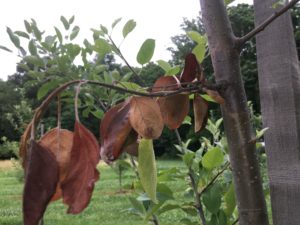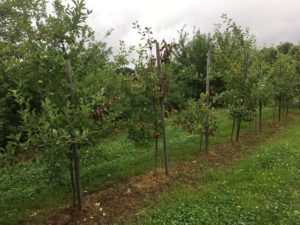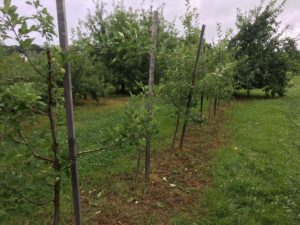Fireblight has reared its ugly head again in the orchard. Numerous hours have been spent trying to control this destructive disease. Fireblight is caused by the Erwinia amylovora. This bacterium overwinters in the wood of the trees. During the spring, it spreads by rain, bees, aphids or other insects. Humid conditions, rain, and hail promote disease development and spread.
This disease commonly infects flowers at bloom, killing the flower and gaining entrance to the tree. Infections can spread rapidly. When the bacteria gets into the tree’s inner bark it runs down the limb at a rapid rate. Once infected with this bacterium the blossoms and branches begin to wither and turn black and looks as if they were scorched by fire. Thus, the name “fireblight.” Fireblight will kill young trees if it enters the bark of the central leader. As the progression of the disease begins to slow, it forms a canker which sometimes oozes an orange-brown liquid.
Control of fireblight is not easy. Antibiotics and biological control agents are used during bloom to reduce flower infections. Once in-season, infected wood must be removed by pruning. Pruning cuts must be made below the infected tissue into healthy wood. After each cut, the pruners must be cleaned – we typically use 10% bleach water. The intention of pruning is to reduce the spread of the disease from tree-to-tree as well as reduce the over-wintering innoculum. Resistant varieties are also another way to manage the disease. These varieties slow the rate of disease spread.
Being located in southeastern Indiana, we have a lot of humid and rainy conditions – both during bloom and in-season. Our orchard also contains over 25 varieties, which means we have both susceptible and resistant varieties. This creates challenges in managing this disease across our operation.




What is the success rate of the trees that you cut out the fireblight? Ultimately is it better to prune out the blight or just leave it be to save the tree?
Hey Amy,
It is best to prune out the fireblight in the midwest. The humid conditions will allow the bacterial pathogen to spread.
Good luck,
David